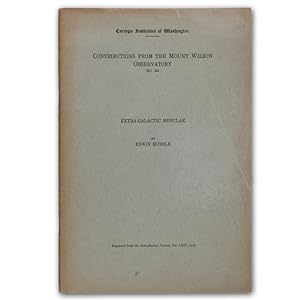Extra-Galactic Nebulae.
Hubble, Edwin.
Verkäufer
Antiquariat Gerhard Gruber, Heilbronn, Deutschland
Verkäuferbewertung 5 von 5 Sternen
![]()
AbeBooks-Verkäufer seit 1. August 2001
Beschreibung
Beschreibung:
(25,5 x 17 cm). 49 S. Mit 1 Tafeln und 3 Abbildungen. Original-Broschur. (Sonderdruck aus: Astrophysical Journal). Erste Ausgabe seines berühmten Klassifizierungssystems für Galaxien. - "Hubble was the first to introduce a significant classification system for galaxies. He presented this at the meeting of the International Astronomical Union at Cambridge, England, in 1925 and it was published the next year in the 'Astrophysical Journal'. This system is the basis of the classification still used. Hubble found that most galaxies showed evidence of rotational symmetry about a dominating central nucleus, although a minority, amounting to not more than 3 percent of those he studied, lacked both these features. He called the two types 'regular' and 'irregular,' respectively. He found that the regular galaxies fell into two main classes - 'spirals' and 'ellipticals' - and that each class contained a regular sequence of forms. One end of the elliptical sequence was found to be similar to one end of the spiral sequence. The spirals were subdivided into two parallel subsequences, normal and barred. The classification was essentially empirical and independent of any assumptions concerning the evolution of galaxies" (DSB). - Hubble (1889-1953) war der Begründer der modernen extragalaktischen Astronomie und der erste, der die Rotverschiebung der Sterne beobachtete und damit den Nachweis für die Expansion des Universums lieferte. - Stempel auf dem Titel. Vorderer Umschlag mit schwachem Knick, sonst gut erhalten. - DSB 6, 529. Bestandsnummer des Verkäufers 112421-01
Bibliografische Details
Titel: Extra-Galactic Nebulae.
Verlag: (Chicago University of Chicago Press)
Erscheinungsdatum: 1926
Einband: Hardcover
Zustand des Schutzumschlags: Schutzumschlag
Auflage: 1. Auflage
Beste Suchergebnisse bei AbeBooks
Extra-Galactic Nebulae in The Astrophysical Journal, LXIV, 64, 1926, pp. 321-369 [HUBBLE'S SEMINAL CLASSIFICATION OF GALAXIES & ESTIMATES OF THEIR DENSITIES, 3 Plates]
Anbieter: Atticus Rare Books, West Branch, IA, USA
FIRST EDITION OF THE SEMINAL PAPER IN WHICH HUBBLE PRESENTS HIS CLASSIFICATION OF GALAXIES, ESTIMATES THEIR MEAN DENSITIES, & DERIVES FOR THE FIRST TIME THE MEAN MASS DENSITY IN GALAXIES IN THE UNIVERSE AS A WHOLE. THE PAPER IS "A MORE OR LESS COMPLETE DESCRIPTION OF GALAXIES AS EXTRAGALACTIC SYSTEMS. & IS THE FIRST APPLICATION OF THE IDEAS OF RELATIVISTIC COSMOLOGY TO THE UNIVERSE OF GALAXIES" (Carnegie Astrophysics Series, 2, 2004). This forty-eight-page paper includes three plates & many tables. In this paper, Hubble "determined the mean density of nebulae in space and applied this result in the theory of general relativity to get the radius of curvature of the finite universe - â??600 times the distance at which normal nebulae can be detected with the 100-inch reflector.' This calculation represented the boldest probe of the universe yet made and [that] greatly stimulated theoretical work in cosmology" (Mayall, Hubble: A Biographical Memoir, National Academy of Sciences). The prophetic last sentence of this paper reads: "with reasonable increases in the speed of the plates and size of telescopes, it may become possible to observe an appreciable fraction of the Einstein universe" (Hubble, 369). And he was right. Just three years later, Hubble would use the observational evidence collected for this 1926 paper to help formulate Hubble's law which, in stating that galaxies move away from each other at a speed proportional to their distance, effectively validated solutions to the equations of general relativity in which the universe is in motion. While developing the morphological classification of galaxies he presents in this paper, "Hubble discovered an odd fact: Almost every galaxy he observed appeared to be moving away from the Earth. He knew this because the light coming from the galaxies exhibited redshift. Building on the work of Vesto Slipher, who measured the redshifts associated with galaxies more than a decade earlier, Hubble. discovered [in his own data] a rough proportionality between the distances and redshifts of the galaxies studied" (Google Classroom). In other words, in 1926, Hubble already had "a pretty good idea that [the] data showed a linear relationship between redshift and distance - that redshift is proportional to distance, so that if one galaxy has twice as big a redshift as another, it is twice as far away. Indeed, he must have had some idea of this already in 1926., but he was extremely cautious about putting this conclusion down in print" (Gribin, The Birth of Time). Three years later when he was ready, Hubble formulated Hubble's law, showing that "galaxies are receding away from us with a velocity that is proportional to their distance from us: more distant galaxies recede faster than nearby galaxies. It was proof that the Universe is expanding," an idea that has "made as great a change in man's conception of the universe as the Copernican revolution 400 years before" (PNAS 112, 11; DSB). CONDITION & DETAILS: Complete. Chicago: University of Chicago Press. Complete. Ex-libris marking on the front flyleaf and pastedown. NO spine markings whatsoever. 4to (9.75 x 6.75 inches). [5], vi, [374], 4. Nineteen plates and in-text illustrations throughout. Tightly bound in red buckram. Gilt-lettered at the spine. Light spotting at foot of spine, otherwise bright & clean. Very good +. Bestandsnummer des Verkäufers 1639
Anzahl: 1 verfügbar

